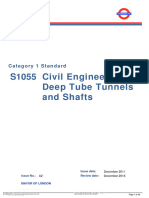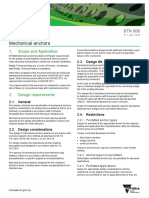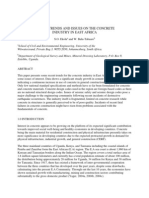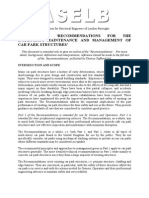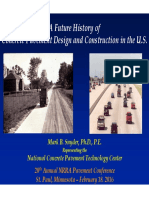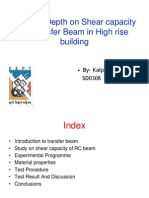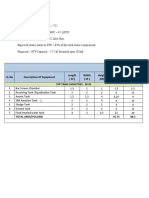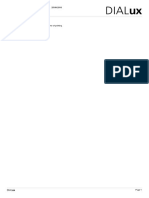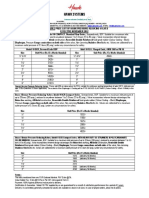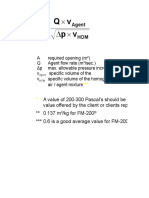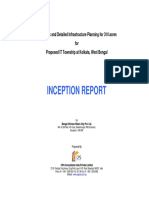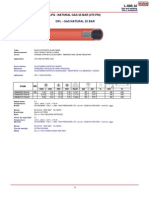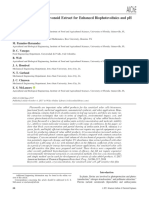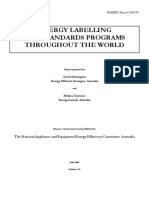The Design of Concrete Highway Bridges and Structures With External and Unbonded Prestressing
The Design of Concrete Highway Bridges and Structures With External and Unbonded Prestressing
Uploaded by
Manjunath HrmCopyright:
Available Formats
The Design of Concrete Highway Bridges and Structures With External and Unbonded Prestressing
The Design of Concrete Highway Bridges and Structures With External and Unbonded Prestressing
Uploaded by
Manjunath HrmOriginal Description:
Original Title
Copyright
Available Formats
Share this document
Did you find this document useful?
Is this content inappropriate?
Copyright:
Available Formats
The Design of Concrete Highway Bridges and Structures With External and Unbonded Prestressing
The Design of Concrete Highway Bridges and Structures With External and Unbonded Prestressing
Uploaded by
Manjunath HrmCopyright:
Available Formats
THE HIGHWAYS AGENCY BA 58/94
THE SCOTTISH OFFICE DEVELOPMENT DEPARTMENT
THE WELSH OFFICE
Y SWYDDFA GYMREIG
THE DEPARTMENT OF
THE ENVIRONMENT FOR NORTHERN IRELAND
The Design of Concrete Highway
Bridges and Structures with
External and Unbonded
Prestressing
Summary: This Advice Note provides guidance on the design of bridges with external
and unbonded prestressing.
This Advice Note provides advice on specification requirements for use in
public purchasing contracts. It does not lay down legislative requirements for
products and materials used in highway construction in the United Kingdom.
Volume 1 Section 3
Part 10 BA 58/94 Registration of Amendments
REGISTRATION OF AMENDMENTS
Amend Page No Signature & Date of Amend Page No Signature & Date of
No incorporation of No incorporation of
amendments amendments
ELECTRONIC COPY - NOT FOR USE OUTSIDE THE AGENCY
November 1994 PAPER COPIES OF THIS ELECTRONIC DOCUMENT ARE UNCONTROLLED
Volume 1 Section 3
Registration of Amendments Part 10 BA 58/94
REGISTRATION OF AMENDMENTS
Amend Page No Signature & Date of Amend Page No Signature & Date of
No incorporation of No incorporation of
amendments amendments
ELECTRONIC COPY - NOT FOR USE OUTSIDE THE AGENCY
PAPER COPIES OF THIS ELECTRONIC DOCUMENT ARE UNCONTROLLED November 1994
DESIGN MANUAL FOR ROADS AND BRIDGES
VOLUME 1 HIGHWAYS
STRUCTURES:
APPROVAL
PROCEDURES AND
GENERAL DESIGN
SECTION 3 GENERAL DESIGN
PART 10
BA 58/94
THE DESIGN OF CONCRETE
HIGHWAY BRIDGES AND
STRUCTURES WITH EXTERNAL
AND UNBONDED PRESTRESSING
Contents
Chapter
1. Introduction
2. Conceptual Design
3. Detailed Design
4. Corrosion Protection
5. References
6. Enquiries
ELECTRONIC COPY - NOT FOR USE OUTSIDE THE AGENCY
November 1994 PAPER COPIES OF THIS ELECTRONIC DOCUMENT ARE UNCONTROLLED
Volume 1 Section 3 Chapter 1
Part 10 BA 58/94 Introduction
1. INTRODUCTION
General for the procurement of products which do not include
these Clauses must contain a suitable clause of mutual
1.1 The Design of prestressed concrete structures recognition having the same effect regarding which
with external or unbonded prestressing is not covered in advice should be sought.
the current Code of Practice for the design of concrete
bridges, BS 5400 Part 4. This coupled with durability
problems experienced by some structures with external Scope
prestressing has resulted in this type of construction
being seldom used in this country. 1.6 This Advice Note provides guidance on the use
of unbonded prestressing and some background
1.2 Tendon corrosion associated with the ingress of information on the design requirements set out in
de-icing salts through inadequately grouted ducts, has BD 58, the Design of Concrete Highway Bridges and
been encountered in a number of structures of bonded Structures with External and Unbonded Prestressing.
post-tensioned construction. Recent sudden collapses
of bridges with bonded tendons is a cause for concern,
especially as there are no satisfactory means available Definition
to monitor the condition of tendons. As a result, the
Overseeing Organisations wish to encourage the use of 1.7 Unbonded prestressing is prestressing where, in
external and unbonded tendons as a form of the finished structure, no continuous bond is provided
construction which can be easily inspected, monitored between the prestressing elements and the concrete
and maintained. section, either by the provision of grout or by any other
means. The term, external prestressing is applied to that
1.3 This Advice Note should be used in class of unbonded prestressed structures where some or
conjunction with BD 57 (DMRB 1.3.7) and BA 57 all of the prestressing is unbonded and outside the
(DMRB 1.3.8) Design for Durability, particularly as concrete section, and where the load is transferred to the
regards access to enclosed spaces and the quality of concrete through end anchorages and deviators. It is, in
protection from environmental effects (including theory, possible to use unbonded prestressing elements
leakage) within enclosed spaces. in ducts which lie within the concrete section. This is
unbonded internal prestressing.
Implementation
1.4 This Advice Note may be used forthwith for
schemes currently being prepared provided that, in the
opinion of the Overseeing Organisation, this would not
result in significant additional expense or delay
progress. Design Organisations should confirm its
application to particular schemes with the Overseeing
Organisation.
1.5 Where this Document is applied for products
which are procured through a contract incorporating the
Specification for Highway Works (MCHW 1), products
conforming to equivalent standards and specifications
of other states of the European Economic Area will be
acceptable in accordance with the terms of the 104 and
105 Series of Clauses of that Specification. Any
contract
ELECTRONIC COPY - NOT FOR USE OUTSIDE THE AGENCY
November 1994 PAPER COPIES OF THIS ELECTRONIC DOCUMENT ARE UNCONTROLLED 1/1
Volume 1 Section 3 Chapter 2
Part 10 BA 58/94 Conceptual Design
2. CONCEPTUAL DESIGN
Factors affecting choice ii. The increase in cable force at ultimate is less
than that with bonded tendons, and hence the
2.1 The choice of whether to use external or ultimate flexural capacity of a section is usually
unbonded prestressing should be made at the conceptual reduced. Slightly deeper structures may be
design stage as it is likely to affect a structure's form required to compensate for this.
and dimensions. Although external prestressing is
unlikely to be economical in structures spanning less iii. In external prestressing, the cables are not
than 40m, when whole life costs are considered its use protected by concrete and hence are more
may be justified. vulnerable to terrorist attack or fire.
iv. In the event of a tendon failure, tendons do not
2.2 Advantages have the capability to rebond.
The following is a list of advantages associated with the v. The strength of the structure is dependent on
use of unbonded prestressing: the anchorages.
i. Facilities for inspection, monitoring and re-
stressing or replacing of tendons can be easily Maintenance and Replacement
incorporated.
2.4 Concrete boxes housing external tendons
ii. The lack of ducts within concrete when using should ideally have a reasonable working space and
external prestressing makes steel fixing easier means of access; see Design for Durability, BD 57
and facilitates the use of thinner webs, thereby (DMRB 1.3.7) and BA 57. (DMRB 1.3.8). This
resulting in a reduction in dead load. requirement would result in a practical minimum span
for externally prestressed structures of about 40m.
iii. External tendons afford simpler cable layouts. Where external prestressing is used on shorter spans, a
reduced headroom may be used with the agreement of
iv. Prestress loss due to both friction and creep is the Overseeing Organisation provided that the full
lower. requirements of Health and Safety legislation are met.
v. Flexural failures will always be preceded by 2.5 Provision should be made for the replacement
extensive cracking and excessive deflection, and re-stressing of tendons. The structure should be
thus giving prior warning of collapse. capable of accommodating a range of prestressing force
resulting from future tendon replacement, and galleries
vi. Since the opening and closing of cracks does should be incorporated at abutments with sufficient
not affect the tendon stress, as in the case of room to manoeuvre prestressing jacks. The provision
bonded construction, and as corrosion of runway beams, which may also be used to facilitate
protection to the tendons is not dependent on construction, would be desirable. For further
the encasing concrete, the serviceability information on the design of abutment galleries see The
requirement for crack widths can be relaxed for Design for Durability, BD 57 (DMRB 1.3.7) and BA
external prestressing. 57 (DMRB 1.3.8).
2.3 Disadvantages Robustness
The following is a list of disadvantages associated with 2.6 The local failure of tendons in a bonded post-
the use of unbonded prestressing: tensioned structure would not normally have a
significant effect on its ultimate load capacity as the
i. In external prestressing the maximum cable tendons rebond with the concrete. However, in the case
eccentricity is likely to be less than for bonded of unbonded prestressing, failure in any position makes
post-tensioning. a tendon ineffective over its entire length. Hence
structures with unbonded prestressing may be
ELECTRONIC COPY - NOT FOR USE OUTSIDE THE AGENCY
November 1994 PAPER COPIES OF THIS ELECTRONIC DOCUMENT ARE UNCONTROLLED 2/1
Chapter 2 Volume 1 Section 3
Conceptual Design Part 10 BA 58/94
vulnerable to a disproportionate collapse. This is
particularly true for continuous bridge decks where
localised failure in one span could result in a
progressive collapse of adjacent spans.
2.8 The design criteria in BD 58 (DMRB 1.3)
introduce a check to ensure that structures with
unbonded prestressing will not collapse as a result of a
local tendon failure. This requirement may have a
significant influence on a structure's form. For instance,
the position of anchorages in continuous structures may
need to be staggered or box girder decks may require
transverse stiffening to prevent collapse following a loss
of tendons in an external web.
Demolition
2.9 In practice, when cut or broken, conventional
grouted or pretensioned tendons will re-anchor and
hence the energy stored in the tendon is not released.
However, cutting unbonded tendons will release much
greater amounts of energy. It should therefore be
avoided in demolishing structures with unbonded pre-
stressing.
2.10 As re-stressable tendons can be de-stressed
individually, demolition of structures with unbonded
prestressing is usually quite straightforward. However
the effect on adjacent spans of de-stressing multi-span
cables should be carefully considered.
2.11 In short span bridges where the provision of
abutment galleries is not feasible, anchorages should
nevertheless be detailed to facilitate future de-
tensioning for demolition.
ELECTRONIC COPY - NOT FOR USE OUTSIDE THE AGENCY
2/2 PAPER COPIES OF THIS ELECTRONIC DOCUMENT ARE UNCONTROLLED November 1994
Volume 1 Section 3 Chapter 3
Part 10 BA 58/94 Detailed Design
3. DETAILED DESIGN
General Shear
3.1 This Chapter deals with the detailed design of 3.6 The design rules for shear in beams given in
post-tensioned concrete with external and unbonded BS 5400 Part 4 are empirical and based on test results
prestressing. It includes some information on the on bonded tendons. They are therefore not considered
background to the design requirements contained in BD appropriate for unbonded prestressing. The approach
58 (DMRB 1.3.9. The Design of Concrete Highway adopted for determining shear resistance is to treat
Bridges and Structures with External and Unbonded unbonded prestressing as reinforced sections with an
Prestressing). externally applied load (See Clause 6.3.4.1).
3.2 References to Clause numbers in this chapter 3.7 The design for shear is based on a form of truss
refer to BS 5400 as modified by BD 58 (DMRB 1.3.9). analogy and thus implies a greater force in the tension
cord than would be expected by simple bending theory.
This has been reflected in BS 5400: Part 4: 1990.
Flexure However, in the case of unbonded prestressing it is
necessary to check that the requisite tendon force rather
3.3 As the ultimate strength of structures with than tendon strength, is available. This has been
unbonded prestressing is dependent on the prestress addressed in BD 58 (DMRB 1.3.9) by adding a
force, allowance must be made for the actual prestress requirement to extend tendons beyond the section at
force present being less than that which is assumed in which they are required. (See Clause 6.3.3.1(g)).
design. This may be, for instance, as a result of the
jacking force being less than intended or the prestress
loss being greater than calculated. A partial safety Torsion
factor (FL of 0.87 is therefore applied to the prestress
force. (See Clause 6.3.3.1(d)). 3.8 As the torsion rules for bonded tendons in BS
5400 Part 4 make no allowance for the beneficial effects
3.4 Since the strain in unbonded tendons at the of prestress, they do not require modification for the use
ultimate limit state is unlikely to be sufficient to cause of unbonded tendons.
yield, failure is likely to be through crushing of the
concrete. However, the overall behaviour of the
structure should remain ductile with extensive cracking Prestress Loss
and excessive deflections being apparent before yield.
It is, therefore, not felt necessary to impose the 15% 3.9 The use of unducted systems or ducts with
over strength requirement that is prescribed for over- greased or waxed strands means that prestressing
reinforced bonded prestressed sections. systems used in external and unbonded prestressing
have lower coefficients of friction than bonded systems.
3.5 In bonded prestressed construction plane In addition, with external prestressing wobble losses are
sections, including their prestressing tendons, are eliminated.
assumed to remain plane. This assumption depends on
the tendons remaining bonded to the concrete and is 3.10 Although the lack of bond will not alter the
therefore not valid with unbonded prestressing. The average loss due to creep, as the creep losses are
increase in steel strain in unbonded prestressing at constant over the length of a beam, losses at critical
failure is less than for bonded tendons and usually not sections are likely to be smaller than with bonded
sufficient to reach yield. Clause 6.3.3.1(f) introduces a construction. This may be significant in shorter spans
simple but conservative rule to estimate the increase in where the permanent compressive stresses for live loads
steel strain, and hence stress at failure. As an are high.
alternative a more rigorous non-linear analysis may be
used.
November 1994 3/1
Chapter 3 Volume 1 Section 3
Detailed Design Part 10 BA 58/94
Anchors and Deviators in tendon associated with cracks in bonded
construction, are not relevant to unbonded prestressing,
3.11 The strength of structures with unbonded the serviceability cracking criteria have been relaxed in
prestressing is dependent on the anchors and, where the case of external prestressing (see Clause 4.2.2).
they are used, the deviators. This is particularly
significant as the failure mode of anchors and deviators 3.18 In the case of internal unbonded tendons, as the
may be brittle. tendons are not easily inspected and as durability
problems associated with tendon corrosion are less easy
3.12 The design of members with unbonded to detect, the serviceability requirements have not been
prestressing for flexure and shear is based on a lower relaxed.
bound estimate of tendon force. However, anchors and
deviators should be designed for the unfactored tendon
strength. (See Clauses 6.7.5, 6.7.6). Untensioned Reinforcement
3.13 If tendons are not adequately restrained within 3.19 In order to control thermal and shrinkage
the concrete section, the deformation of the concrete cracking and facilitate construction, a requirement for
between deviators can have a significant effect on the nominal untensioned reinforcement has been introduced
moment applied by the tendon to the concrete section. in Clause 6.8.4.
In addition, inadequately restrained tendons may vibrate
excessively and be susceptible to fatigue failure.
Compliance with the requirements of Clause 6.8.8 will Segmental Construction
ensure that tendons are adequately restrained.
3.20 The "dry jointing" technique, where joints
between segments are constructed without the use of
Radius of Curvature epoxy or other suitable materials, has been used on
several long span bridges, especially in the USA.
3.14 Clause 6.8.8 sets out the minimum radius of However, with this method of jointing, a watertight seal
curvature of tendons in deviators. If a specific tendon cannot be achieved at the segment joints. This would
and duct or shoe type is tested or investigated and found therefore reduce the corrosion protection of internal
to be satisfactory for smaller radii, the resulting values grouted tendons. For this reason dry jointing may only
can be used. be used in segmental construction in association with
external tendons.
3.15 Smaller radii may be used in positions where
there is no significant movement of the cable relative to
the duct or shoe in the bend; for example loop anchors
at the centre of cable length.
Serviceability
3.16 In the design of bridges with bonded
prestressing to BS 5400 Part 4, for the serviceability
limit state, the force in the tendons due to deformation
resulting from the applied load is normally ignored. As
this is analogous to unbonded tendons, the BS 5400:
Part 4 design approach for serviceability can be adopted
for unbonded prestressing.
3.17 As the tendons in externally prestressed,
structures do not rely on the concrete for corrosion
protection, and as the problem of high stress fluctuations
3/2 November 1994
Volume 1 Section 3 Chapter 4
Part 10 BA 58/94 Corrosion Protection
4. CORROSION PROTECTION
General 4.6 Unbonded tendons within ducts may be
corrosion protected with galvanising, painted in a light
4.1 Corrosion protection systems for unbonded colour to aid inspection, or with a suitable system which
prestressing should be considered in relation to the allows for tendon replacement and restressing.
overall design of the structure. As tendon corrosion
would only take place in a damp environment, every
effort should be made by good design, detailing and Anchorages
specification of materials, to ensure that water is
excluded from ducts and concrete box enclosures. See 4.7 As the prestressing force in unbonded
the Design for Durability, BD 57 (DMRB 1.3.7) and prestressing is transferred to the concrete solely through
BA 57 (DMRB 1.3.8). the anchorages, care should be taken to exclude water
from the vicinity of anchorages. Anchorage ends
should be open and inspectable, and anchorage pockets
External Prestress should be sealed by means of removable cover plates.
Projecting tendons and anchor plates should be
4.2 For maintenance reasons it is advisable that protected with a suitable water excluding wrapping
external tendons can be inspected easily and are tape.
replaceable. External tendons enclosed within a
concrete box are subject to an environment in which 4.8 The position at which tendons are gripped at
corrosion rates are negligible. It is therefore considered the anchorage is a potential location of bi-metallic
sufficient to provide corrosion protection by galvanising corrosion. Anchorage plates and wedges should
tendons in accordance with BS 2763. Other forms of therefore be of the same type of steel as the tendon.
corrosion protection may also be considered. Designers
should be aware of the possibility of hydrogen 4.9 Care should be taken to ensure that anchorage
embrittlement and galvanic corrosion associated with systems and the detailing of tendons at the anchorages
galvanising and take the necessary precautions to ensure can facilitate the de-tensioning and re-stressing of
against them. tendons.
4.3 Unducted galvanised tendons have the
advantage of being easily inspected throughout their
length.
4.4 In detailing deviators, the use of open shoe-
type deviators may be preferable to the use of closed
duct-type deviators since they allow more complete
inspection of the condition of the tendons at deviator
positions.
Unbonded Tendons
4.5 Ducts for unbonded tendons within the
concrete section should be made from High Density
Polyethylene (HDPE) with a minimum wall thickness
of 2mm, or other suitable materials. Ducts should be
waterproof with drainage holes at low points along their
profile to release any water that may be trapped and to
facilitate inspection by means of an endoscope.
ELECTRONIC COPY - NOT FOR USE OUTSIDE THE AGENCY
November 1994 PAPER COPIES OF THIS ELECTRONIC DOCUMENT ARE UNCONTROLLED 4/1
Volume 1 Section 3 Chapter 5
Part 10 BA 58/94 References
5. REFERENCES
1. Design Manual for Roads and Bridges
Volume 1: Section 3 General Design
BD 58 The Design of Concrete Highway Bridges and
Structures with External and Unbonded
Prestressing
(DMRB 1.3.9)
BD 57 Design for Durability (DMRB 1.3.7)
BA 57 Design for Durability (DMRB 1.3.8)
2. British Standards
BS 5400: Part 4: 1990: Code of Practice for the Design
of Concrete Highway Structures.
BS 2763: 1982: Specification for Round Carbon Steel
Wire for Wire Rope.
ELECTRONIC COPY - NOT FOR USE OUTSIDE THE AGENCY
November 1994 PAPER COPIES OF THIS ELECTRONIC DOCUMENT ARE UNCONTROLLED 5/1
Volume 1 Section 3 Chapter 6
Part 10 BA 58/94 Enquiries
6. ENQUIRIES
All technical enquiries or comments on this Advice Note should be sent in writing as appropriate to:
Head of Bridges Engineering Division
The Highways Agency
St Christopher House
Southwark Street A. J. PICKETT
London SE1 0TE Head of Bridges Engineering Division
The Deputy Chief Engineer
The Scottish Office Industry Department
Roads Directorate
New St Andrew's House J INNES
Edinburgh EH1 3TG Deputy Chief Engineer
The Director of Highways
Welsh Office
Y Swyddfa Gymreig
Government Buildings
Ty Glas Road B H HAWKER
Llanishen Head of Roads Engineering
Cardiff CF4 5PL (Construction) Division
Chief Engineer - Roads Service
Department of the Environment for
Northern Ireland
Roads Service Headquarters
Clarence Court
10-18 Adelaide Street D O'HAGAN
Belfast BT2 8GB Assistant Chief Engineer (Works)
ELECTRONIC COPY - NOT FOR USE OUTSIDE THE AGENCY
November 1994 PAPER COPIES OF THIS ELECTRONIC DOCUMENT ARE UNCONTROLLED 6/1
You might also like
- S1055 Civil Engineering - Deep Tube Tunnels and ShaftsDocument48 pagesS1055 Civil Engineering - Deep Tube Tunnels and ShaftsJorge SalasënNo ratings yet
- Plant Commissioning & Start Up ProcedureDocument18 pagesPlant Commissioning & Start Up Procedureaamirapi100% (10)
- Clark1976 PDFDocument10 pagesClark1976 PDFLuis Ariel B. MorilloNo ratings yet
- Bridge Technical Note 2018 - 008 Mechanical Anchors June 2018Document2 pagesBridge Technical Note 2018 - 008 Mechanical Anchors June 2018Thong NguyenNo ratings yet
- BD 58-94 Bridges With External PrestressingDocument10 pagesBD 58-94 Bridges With External Prestressingmahmoud elkhedrNo ratings yet
- Water Mist CalculationDocument26 pagesWater Mist CalculationManjunath Hrm100% (1)
- Radial Gate AnalysisDocument16 pagesRadial Gate AnalysisAkshay Badhani100% (1)
- Ba 3094Document29 pagesBa 3094massive85No ratings yet
- The Assessment of Steel Highway and Bridges - BA56 - 96Document114 pagesThe Assessment of Steel Highway and Bridges - BA56 - 96pratip_bNo ratings yet
- Ba3993 Assesment of Reinforced Concrete Half-JointedDocument22 pagesBa3993 Assesment of Reinforced Concrete Half-JointedvaleNo ratings yet
- BD 6110Document161 pagesBD 6110Ong George SammyNo ratings yet
- 03 12 General Design Design of Integral Bridges PDFDocument15 pages03 12 General Design Design of Integral Bridges PDFshardasiddhNo ratings yet
- BD 2101Document77 pagesBD 2101babarkhattakNo ratings yet
- bd4415 PDFDocument130 pagesbd4415 PDFanon_585056087No ratings yet
- Summary of Items Discussed in 2 - 2024 ADF On 3.5.2024Document10 pagesSummary of Items Discussed in 2 - 2024 ADF On 3.5.2024YUK LAM WONGNo ratings yet
- Span Vs Super T Depth - NSWDocument4 pagesSpan Vs Super T Depth - NSWAAMIRNo ratings yet
- 14.03 - General Design - Design of Steel Bridges BD 13-90Document27 pages14.03 - General Design - Design of Steel Bridges BD 13-90Oscar MendozaNo ratings yet
- SS EN 13670-2022 PreviewDocument11 pagesSS EN 13670-2022 PreviewSrdjan Georgiev0% (1)
- Guidance Notes On The Use of Waterprrofing MembranesDocument17 pagesGuidance Notes On The Use of Waterprrofing MembranesDanny LamNo ratings yet
- Constn Price List January 2011 FinalDocument40 pagesConstn Price List January 2011 FinalBurak BaşNo ratings yet
- 2023 08 20 Nanga Merit ReviewDocument31 pages2023 08 20 Nanga Merit ReviewCliff Jude ZehnderNo ratings yet
- The Effect of Excess Water in ConcreteDocument2 pagesThe Effect of Excess Water in ConcreteKevin NacalabanNo ratings yet
- 2012 - Compressive Strength of Concrete After Early LoadingDocument7 pages2012 - Compressive Strength of Concrete After Early LoadingafuhcivNo ratings yet
- SCI P298 Stainless Steel Masonry Support SystemsDocument2 pagesSCI P298 Stainless Steel Masonry Support SystemsMan Ho LamNo ratings yet
- MCHW Vol 1 Series 500 Web PDFDocument41 pagesMCHW Vol 1 Series 500 Web PDFMohammed sabatinNo ratings yet
- From CP 114 To BS8110 EssayDocument10 pagesFrom CP 114 To BS8110 EssayAlan CheungNo ratings yet
- Lockable Dowels: For Temporary Movement Joints in Post-Tensioned ConcreteDocument12 pagesLockable Dowels: For Temporary Movement Joints in Post-Tensioned ConcreteDaniel ChangNo ratings yet
- Swivel Joist-Expansion Joints: (With/without Noise Reduction)Document48 pagesSwivel Joist-Expansion Joints: (With/without Noise Reduction)Tamaduianu IoanNo ratings yet
- Bridge Technical Note 1999002V21Document5 pagesBridge Technical Note 1999002V21er_surajrpNo ratings yet
- Design of Columns Euro CodeDocument10 pagesDesign of Columns Euro CodeSomeshwar GantiNo ratings yet
- Bridge Technical Note 2018 - 007 Noise Attenuation Walls June 2018Document3 pagesBridge Technical Note 2018 - 007 Noise Attenuation Walls June 2018Thong NguyenNo ratings yet
- E-4-2 Traffic Appraisal Manual, Chapter 13Document26 pagesE-4-2 Traffic Appraisal Manual, Chapter 13sareenpriya100% (1)
- Comparison of One-And Two-Way Slab Minimum Thickness Provisions in Building Codes and StandardsDocument7 pagesComparison of One-And Two-Way Slab Minimum Thickness Provisions in Building Codes and StandardsM Refaat FathNo ratings yet
- Outline Of: Recommendations For The: Inspection, Maintenance and Management of Car Park Structures'Document10 pagesOutline Of: Recommendations For The: Inspection, Maintenance and Management of Car Park Structures'Fyza HoneyNo ratings yet
- Recommendations For Design and Construction of Ultra High Strength Concrete Structures, - DraftDocument4 pagesRecommendations For Design and Construction of Ultra High Strength Concrete Structures, - DraftMashfiqul IslamNo ratings yet
- Structural Use of Concrete Code of Practice For Design and ConstructionDocument8 pagesStructural Use of Concrete Code of Practice For Design and ConstructionAdminMantapNo ratings yet
- Bridge Technical Note 1999006V21Document4 pagesBridge Technical Note 1999006V21er_surajrpNo ratings yet
- A New Method of Quality Control For Construction Joints in Diaphragm WallsDocument11 pagesA New Method of Quality Control For Construction Joints in Diaphragm WallsfreezefreezeNo ratings yet
- Ha 12008Document28 pagesHa 12008BogdanBNo ratings yet
- NA To Sls en 1991-2 2021Document54 pagesNA To Sls en 1991-2 2021Gobidan NavanesanNo ratings yet
- CD 354 Revision 1 Design of Minor Structures-WebDocument64 pagesCD 354 Revision 1 Design of Minor Structures-Webgaurav sharmaNo ratings yet
- Bridge 06 ConcreteDocument17 pagesBridge 06 ConcretethakrarhitsNo ratings yet
- DD Cen TS 12390-10-2007Document24 pagesDD Cen TS 12390-10-2007DoicielNo ratings yet
- Future History of Concrete PavementDocument67 pagesFuture History of Concrete Pavementgk_kishoree81100% (1)
- BRE IP513 Durability of AACMsDocument13 pagesBRE IP513 Durability of AACMsAndy FrostNo ratings yet
- Staircases and BalconiesDocument4 pagesStaircases and Balconieskundanika prasadNo ratings yet
- Advances in The Analysis of Simply Supported Concrete Bridge Deck PDFDocument16 pagesAdvances in The Analysis of Simply Supported Concrete Bridge Deck PDFDarshan GowdaNo ratings yet
- Effect of Depth On Shear Capacity of Transfer Beam in High Rise BuildingDocument46 pagesEffect of Depth On Shear Capacity of Transfer Beam in High Rise BuildingSheffy Abraham100% (1)
- Tests To Establish Concrete Pumpability Jl74-19Document11 pagesTests To Establish Concrete Pumpability Jl74-19saiNo ratings yet
- Analytical Study On Safety Level of Stay Cables of Cable Stayed BridgeDocument8 pagesAnalytical Study On Safety Level of Stay Cables of Cable Stayed Bridgesushil deshmukhNo ratings yet
- Use of Control Charts in The Production of Concrete: by Ian Gibb and Tom Harrison October 2010Document55 pagesUse of Control Charts in The Production of Concrete: by Ian Gibb and Tom Harrison October 2010Henock ShewasemaNo ratings yet
- 3S Structural Engineering Design Manual - Revision 5Document74 pages3S Structural Engineering Design Manual - Revision 5Lampard ChenNo ratings yet
- Britpavedigital 192206Document301 pagesBritpavedigital 192206Pedro LeguizamoNo ratings yet
- Bridge Articulation and Bearing SpecificationDocument16 pagesBridge Articulation and Bearing SpecificationSamuel AntobamNo ratings yet
- terastandard bsi-bs-en-523-567استاندارد آشنایی با اصطلاحات فنی و نیازها و کنترل کیفیت غلاف پیش تنیگیDocument20 pagesterastandard bsi-bs-en-523-567استاندارد آشنایی با اصطلاحات فنی و نیازها و کنترل کیفیت غلاف پیش تنیگیganmosesNo ratings yet
- Macro Synthetic Fibre For Segmental Linings and Other Precast ConcreteDocument3 pagesMacro Synthetic Fibre For Segmental Linings and Other Precast ConcreteDiego SchneiderNo ratings yet
- Prestressed Steel BeamDocument17 pagesPrestressed Steel Beamvarun sainiNo ratings yet
- Strengthening and Retrofitting of RC Beams Using Fiber Reinforced PolymersDocument6 pagesStrengthening and Retrofitting of RC Beams Using Fiber Reinforced Polymersmanish tomarNo ratings yet
- A Catalogue of Details on Pre-Contract Schedules: Surgical Eye Centre of Excellence - KathFrom EverandA Catalogue of Details on Pre-Contract Schedules: Surgical Eye Centre of Excellence - KathNo ratings yet
- Tack Welding of Reinforcement BarsDocument16 pagesTack Welding of Reinforcement BarsArlandooNo ratings yet
- BD 33-94 Expansion Joints For Use in Highway Bridge DecksDocument18 pagesBD 33-94 Expansion Joints For Use in Highway Bridge DecksBeacher Q100% (1)
- Statistics: 10.1 Mean and Standard Deviation - Single DataDocument20 pagesStatistics: 10.1 Mean and Standard Deviation - Single DataManjunath HrmNo ratings yet
- Plant CapacityDocument1 pagePlant CapacityManjunath HrmNo ratings yet
- Swimming Pool DesignDocument2 pagesSwimming Pool DesignManjunath Hrm100% (3)
- TYPICAL CLASS ROOM / Table of ContentsDocument1 pageTYPICAL CLASS ROOM / Table of ContentsManjunath HrmNo ratings yet
- Freeware PDF UnlockerDocument116 pagesFreeware PDF UnlockerManjunath HrmNo ratings yet
- New PricelistDocument1 pageNew PricelistManjunath HrmNo ratings yet
- Novec VentingoutDocument2 pagesNovec VentingoutManjunath HrmNo ratings yet
- Novec VentingoutDocument2 pagesNovec VentingoutManjunath HrmNo ratings yet
- Interview TipsDocument26 pagesInterview TipsManjunath HrmNo ratings yet
- Revenue by Quarters: Q1 Q2 Q3 Q4Document4 pagesRevenue by Quarters: Q1 Q2 Q3 Q4Manjunath HrmNo ratings yet
- 00.discrimination Study Report-Wipro CoimbatoreDocument30 pages00.discrimination Study Report-Wipro CoimbatoreManjunath HrmNo ratings yet
- Final Inception Report PDFDocument92 pagesFinal Inception Report PDFManjunath Hrm100% (2)
- Pumps - 27lps at 90m Head.: Kaveri Watermarke - Cost Difference Between 10 Floor and 14 Floor. Fire Protection SystemsDocument1 pagePumps - 27lps at 90m Head.: Kaveri Watermarke - Cost Difference Between 10 Floor and 14 Floor. Fire Protection SystemsManjunath HrmNo ratings yet
- Plumbing SystemsDocument7 pagesPlumbing SystemsManjunath HrmNo ratings yet
- Accepted Make of MaterialsDocument2 pagesAccepted Make of MaterialsManjunath HrmNo ratings yet
- Comparison Between Flush Valv E& TankDocument1 pageComparison Between Flush Valv E& TankManjunath HrmNo ratings yet
- Wet Crude ProcessingDocument39 pagesWet Crude ProcessingMohanad HussienNo ratings yet
- Physics Formula SheetDocument2 pagesPhysics Formula SheetFrancis C FrancisNo ratings yet
- KSB Calio SDocument38 pagesKSB Calio SPaško ŠantićNo ratings yet
- Mon Aug 07 23:46:17 2017 Case: C:/... /hysys Prarancangann Pabrik N-Butil Asetat Kapasitas 10000 Ton Per Tahun - HSC Flowsheet: Case (Main)Document1 pageMon Aug 07 23:46:17 2017 Case: C:/... /hysys Prarancangann Pabrik N-Butil Asetat Kapasitas 10000 Ton Per Tahun - HSC Flowsheet: Case (Main)Ikhsan FoldismeNo ratings yet
- Gradation of Aggregates and Its Effects On Properties of ConcreteDocument5 pagesGradation of Aggregates and Its Effects On Properties of Concretestar zainNo ratings yet
- Tangki CPO Tangki Metil Ester Tangki Gliserol Evaporator: Harga Alat Proses (2007)Document93 pagesTangki CPO Tangki Metil Ester Tangki Gliserol Evaporator: Harga Alat Proses (2007)Diah SekarNo ratings yet
- Unit 5: VOCABULARY AND READING Text 1. The Chemical Laboratory Grammar: Theory and Practice SpeakingDocument18 pagesUnit 5: VOCABULARY AND READING Text 1. The Chemical Laboratory Grammar: Theory and Practice SpeakingFitra Aulia RamadaniNo ratings yet
- Fire Research Identified 57 Toxins With Polystyrene CombustionDocument7 pagesFire Research Identified 57 Toxins With Polystyrene CombustionbubisharbiNo ratings yet
- C631217 Bentonite Test PDFDocument6 pagesC631217 Bentonite Test PDFsunitkghosh1No ratings yet
- Cable Cleaner Fiber Connector CleanerDocument5 pagesCable Cleaner Fiber Connector CleanerDiogo NovaesNo ratings yet
- CatalogueDocument78 pagesCatalogueGregory StewartNo ratings yet
- Analysis of Emulsifier in Food Using Chromatographic TechniquesDocument6 pagesAnalysis of Emulsifier in Food Using Chromatographic TechniquesMaria SiahaanNo ratings yet
- Internship Report: Paint Shop Technologies and Rear Axle AssemblyDocument52 pagesInternship Report: Paint Shop Technologies and Rear Axle AssemblyHarshitYadav100% (1)
- 98% Hno3 MSDSDocument7 pages98% Hno3 MSDSSmrutiNo ratings yet
- 1667 Finishfit OIL High GlossDocument2 pages1667 Finishfit OIL High GlossBojan NikolićNo ratings yet
- Saudi Aramco Spring2000 MPFM-field Test PDFDocument10 pagesSaudi Aramco Spring2000 MPFM-field Test PDFAkasNo ratings yet
- Cryoconcentration of Flavonoid Extract For Enhanced Biophotovoltaics and PH Sensitive Thin FilmsDocument12 pagesCryoconcentration of Flavonoid Extract For Enhanced Biophotovoltaics and PH Sensitive Thin Filmslina fernandaNo ratings yet
- Table of PKa and PI ValuesDocument12 pagesTable of PKa and PI ValuesMariel Defensor ContiNo ratings yet
- Propane To Acrylic AcidDocument231 pagesPropane To Acrylic AcidCluisantony Jayco DizeNo ratings yet
- 233 White Oil N70 MsdsDocument5 pages233 White Oil N70 MsdsCloudy DayNo ratings yet
- Digital Radiography The BasicsDocument2 pagesDigital Radiography The BasicsLopez BetoNo ratings yet
- Vanderberg Shell PDFDocument33 pagesVanderberg Shell PDFavijitb100% (2)
- Energy Labelling and Standards Programs Throughout The World - Julio 2004 PDFDocument56 pagesEnergy Labelling and Standards Programs Throughout The World - Julio 2004 PDFOscar EduardoNo ratings yet
- UGEB2380 Course OutlineDocument3 pagesUGEB2380 Course Outline分開倉庫喔噢罰款No ratings yet
- EHS 1001 Compliance FormsDocument18 pagesEHS 1001 Compliance FormsKhuda BukshNo ratings yet
- ASTM D1921-12 Standard Test Method For Particle Size (Sieve Analysis) of Plastic MaterialsDocument6 pagesASTM D1921-12 Standard Test Method For Particle Size (Sieve Analysis) of Plastic Materialsqc.b.chozenplastindoNo ratings yet
